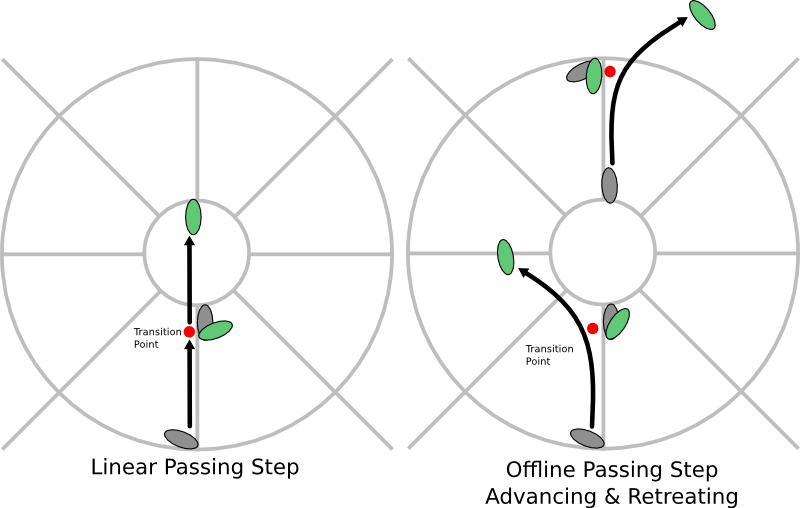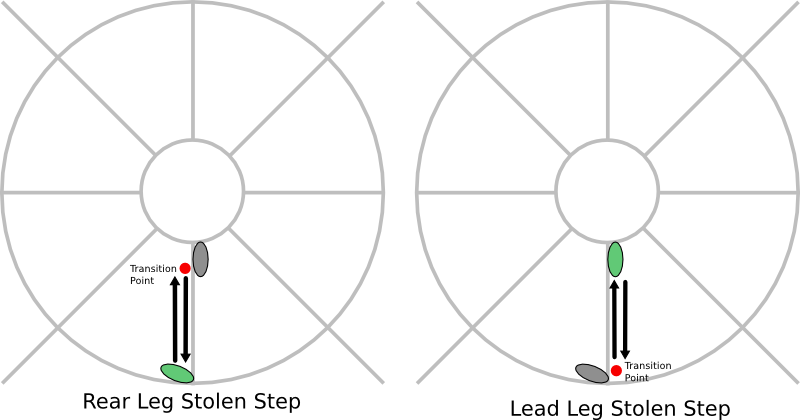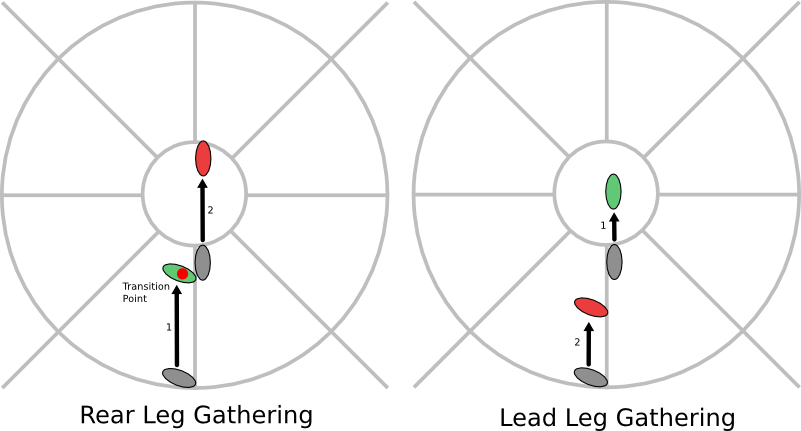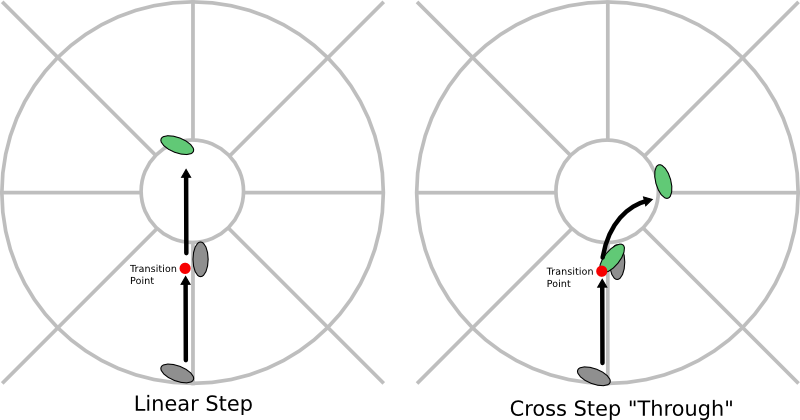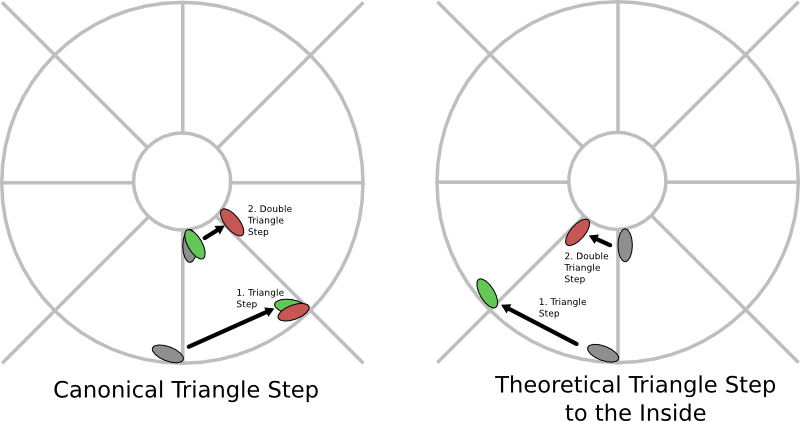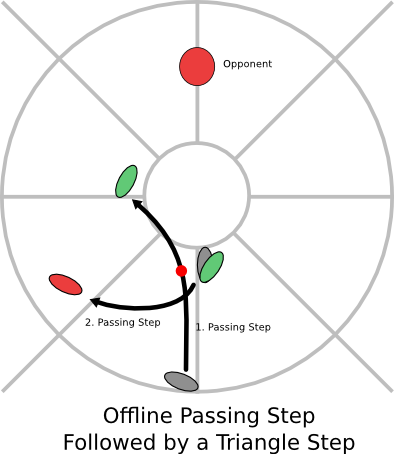Footwork
(→Understanding the Diagrams) |
|||
| (18 intermediate revisions by one user not shown) | |||
| Line 10: | Line 10: | ||
It is not always necessary to use this transition point (an offline passing step, for example, might go directly to its destination, however the theory is useful in many circumstances. | It is not always necessary to use this transition point (an offline passing step, for example, might go directly to its destination, however the theory is useful in many circumstances. | ||
| + | |||
| + | ===Understanding the Diagrams=== | ||
| + | |||
| + | In the footwork diagrams the initial position of the feet is shown in GREY. | ||
| + | |||
| + | The motion of the feet is shown by arrows as well as by the colour of the end position for that foot. The end position is shown in green for the first footfall, and red for the second. | ||
| + | |||
| + | Notice also that some diagrams have a red dot as a "transition point" - this means that the foot being moved passes through this point, and that the fencer may choose to abort the motion, or change to a different step from this position. | ||
===Passing Step=== | ===Passing Step=== | ||
| Line 19: | Line 27: | ||
[[File:Footwork_passingStep.png | center]] | [[File:Footwork_passingStep.png | center]] | ||
| − | ===Glide Step [non-canonical]=== | + | ===Glide Step/Side Step [non-canonical name]=== |
Sometimes when describing a passing step which moves offline, especially while retreating, Meyer refers to the motion as a Glide Step. Consider the retreating passing step offline shown in the previous section - this is the Glide Step from Meyer's [[windthauw]] description. | Sometimes when describing a passing step which moves offline, especially while retreating, Meyer refers to the motion as a Glide Step. Consider the retreating passing step offline shown in the previous section - this is the Glide Step from Meyer's [[windthauw]] description. | ||
| − | ===Stolen | + | ===Stolen Step=== |
The stolen or broken step is a lesser used step which is nevertheless effective when used properly. It is basically a simple half stepping motion which moves one of the feet to the transition point, then moves it back to where it came from. It is "broken" because it is a passing step which we "break" halfway through and return to our starting point, likewise it "breaks" the gathering step in the same way. | The stolen or broken step is a lesser used step which is nevertheless effective when used properly. It is basically a simple half stepping motion which moves one of the feet to the transition point, then moves it back to where it came from. It is "broken" because it is a passing step which we "break" halfway through and return to our starting point, likewise it "breaks" the gathering step in the same way. | ||
| Line 63: | Line 71: | ||
[[File:footwork_gatheringStep.png | center]] | [[File:footwork_gatheringStep.png | center]] | ||
| − | === Cross Step === | + | ===False Step/Cross Step [non canonical name]=== |
The cross step is a movement where you step one leg “across” in front of the other either directly toward the opponent (a linear cross step), or stepping through with the rear leg across the opponent's line. In either case the fencer ends in a cross step [[posture]] with an out-turned lead foot, and generally on the ball of the trailing foot. | The cross step is a movement where you step one leg “across” in front of the other either directly toward the opponent (a linear cross step), or stepping through with the rear leg across the opponent's line. In either case the fencer ends in a cross step [[posture]] with an out-turned lead foot, and generally on the ball of the trailing foot. | ||
| − | The linear cross step allows the fencer to maintain hip alignment through the step. For example, a fencer in a left forward forward weighted [[posture]] would be facing slightly to their right with the hips. If they made a regular passing step through to a forward weighted posture on the opposite side their hips would now face slightly to their left. If they took a cross step, however, the slight angling to the right could be maintained. | + | The linear cross step allows the fencer to maintain hip alignment through the step. For example, a fencer in a left forward forward weighted [[posture]] would be facing slightly to their right with the hips. If they made a regular passing step through to a forward weighted posture on the opposite side their hips would now face slightly to their left. If they took a cross step, however, the slight angling to the right could be maintained. Often this linear cross step isn't a full passing step through, but rather a half step through followed by a regular passing step. |
| − | + | In Meyer's text when a cross step is performed 'through' between the fencer and their opponent, it is described as a false step. For example, if Fencer A is and Fencer B are standing with their left foot forward facing each other, and Fencer A steps through with a cross step of the right leg out to fencer B's right side, then this step in the text would have been described as a false step. In class we use these terms interchangeably. | |
In both cases we pass through the transition point, allowing transformation into a passing, gathering, or broken step as required. | In both cases we pass through the transition point, allowing transformation into a passing, gathering, or broken step as required. | ||
| Line 97: | Line 105: | ||
The movement across can simply compass around, though often moves into a cross step [[posture]]. At this point your overall posture will be very “meyeresque” in that your lead foot will be turned outward to your overall facing very slightly, and your rear leg will be bend and up on the ball of the foot somewhat. | The movement across can simply compass around, though often moves into a cross step [[posture]]. At this point your overall posture will be very “meyeresque” in that your lead foot will be turned outward to your overall facing very slightly, and your rear leg will be bend and up on the ball of the foot somewhat. | ||
| − | + | While it is not canonically named, Meyer also makes use of the triangle step in the other direction. For example in a right lead position the fencer steps around to the left with their left foot. This doesn’t require the twisting/crossing over motion that results from the triangle step to the right from a right lead, but achieves the same purpose. | |
| − | + | ||
| − | + | ||
| − | + | ||
| − | + | ||
| − | + | ||
| − | While it is not | + | |
[[File:footwork_triangleStep.png | center]] | [[File:footwork_triangleStep.png | center]] | ||
| Line 112: | Line 114: | ||
For example, one of the most common combinations of footwork used in longsword is an offline passing step, followed by a triangle step. This allows the fencer to step well offline, then correct their facing with a triangle step, as shown below. | For example, one of the most common combinations of footwork used in longsword is an offline passing step, followed by a triangle step. This allows the fencer to step well offline, then correct their facing with a triangle step, as shown below. | ||
| + | |||
| + | [[File:footwork_passingThenTriangleStep.png | center]] | ||
| + | |||
| + | === Double Step/Double Triangle Step === | ||
| + | |||
| + | The double triangle step is a form of combined footwork and follows from the triangle step. Typically it is performed thus: | ||
| + | |||
| + | * Standing in left forward stance | ||
| + | * Passing Step forward with the right | ||
| + | * Triangle step to the right with the rear (left) foot. | ||
| + | * Step further forward right with the right foot to come back to a regular, right forward weighted [[posture]] | ||
| + | |||
| + | Notice that we've prepended a passing step to the front of the regular triangle step. This is simply because this is the manner in which Meyer most usually uses this footwork (referring to it as the Double Step for simplicity). | ||
Latest revision as of 03:10, 15 June 2017
Not all of the fencing texts from history are clear as to the type of footwork which should be used. Meyer, however, does devote a section of his text to this topic. He describes four specific types of footwork; passing steps, triangle steps, double triangle steps, and stolen steps; we'll use the term 'canonical' for these types of footwork. Through the body of his text he also refers to other methods of stepping without explicitly describing it in the footwork section, including gathering steps, cross steps, and glide/side steps.
In general footwork should be performed while maintaining the broader elements of the posture described in the previous section; the body and hips should act as a single motion segment and the line of motion should not move up and down through the stepping (which is to say no bouncing in the steps should occur, motions should be smooth and even), the head shouldn’t tilt or move, steps should be smooth and fluid, not choppy and uneven. Neither should the foot be stamped down hard (this immediately stiffens the leg and makes you prone to having your balance taken from you).
Generally stepping can be broken into two broad groups; steps which pass through a central point before continuing (transitional steps), and steps which simply go directly to their destination (non-transitional steps)
Contents |
[edit] Transitional Steps
These steps can pass through a central transition point before moving to their destination. This transition point acts as a decision point at which the step can still be changed into a different type of stepping. A passing step can become a stolen step, for example, by reversing the direction of the foot at the transition point and moving back to the original position.
It is not always necessary to use this transition point (an offline passing step, for example, might go directly to its destination, however the theory is useful in many circumstances.
[edit] Understanding the Diagrams
In the footwork diagrams the initial position of the feet is shown in GREY.
The motion of the feet is shown by arrows as well as by the colour of the end position for that foot. The end position is shown in green for the first footfall, and red for the second.
Notice also that some diagrams have a red dot as a "transition point" - this means that the foot being moved passes through this point, and that the fencer may choose to abort the motion, or change to a different step from this position.
[edit] Passing Step
This is the simplest form of stepping and the most natural - essentially it's a large pace forward. The foot passes through the transition point and continues forward so that the front and rear leg have changed their relative position.
Often the passing step will be performed offline to one side or the other as part of a particular technique. For example as our opponent attacks with a straight down cut we might passing step forward to his side to achieve our own technique or counter. The passing step can also be done backwards, in the same way.
[edit] Glide Step/Side Step [non-canonical name]
Sometimes when describing a passing step which moves offline, especially while retreating, Meyer refers to the motion as a Glide Step. Consider the retreating passing step offline shown in the previous section - this is the Glide Step from Meyer's windthauw description.
[edit] Stolen Step
The stolen or broken step is a lesser used step which is nevertheless effective when used properly. It is basically a simple half stepping motion which moves one of the feet to the transition point, then moves it back to where it came from. It is "broken" because it is a passing step which we "break" halfway through and return to our starting point, likewise it "breaks" the gathering step in the same way.
This is useful as an evasion or a feint, and also to manage distance if the opponent moves closer unexpectedly while you were stepping.
A forward stolen step is done as follows:
- Start in a left forward weighted posture.
- Step with the right foot, moving it to the transition point to the side of the lead foot
- Step the right foot back to where it began.
There are variations which can be done on this step; one may step forward with the right then back with the left, or, more commonly, use a backward stolen step as an evasion:
- Start in a left forward stance.
- Step back with the left foot, bringing it beside the right or just in front of it in a kind of T shape.
- Step forward with the left foot, placing it back where it began.
An example of this backward stolen step is often seen in nachreisen techniques; the fencer takes a half step back to let the blade pass by, then back forward with the same foot, cutting at the same time as they come into measure. This same technique is seen in kendo and works by breaking the measure slightly be giving the opponent the idea that one is about to take a step. He reacts accordingly, and thus he finds himself out of measure slightly, be it too close, or too far away.
[edit] Gathering Step
The gathering step is a simple shuffle forward which gathers a short distance between fencers. It is not described explicitly as the gathering step within Meyer’s text, though he often describes its use within his various devices and admonishes the fencer to “gather for a forward step.”
Gathering steps come in two types; rear leg and lead leg gathering.
In rear leg gathering the movement begins with moving the rear leg forward so that the feet are close together (ie. gathering for another step) to our standard transition point, and placing the foot down. The fencer then steps forward again with the front leg back out to distance.
Beginning students might be concerned that this telegraphs the fencer’s action to the opponent. However a gathering step can be deceptive – the final movement may be a gathering step, and offline step, a passing step, a triangle step, or some other stepping motion, it is difficult for the opponent to tell until the motion is made. In this case it telegraphs to the opponent that the fencer is doing something even though they will not know what until the step is completed.
The alternative version of the gathering step is the lead leg gathering.
In this case it is achieved by lifting the front foot slightly and springing yourself with the rear, following immediately with the trailing foot to arrive in the same stance in which the fencer began. Likewise the backward gathering step is executed by lifting the rear foot and pushing off with the front to spring slightly backward.
The lead leg gathering covers a shorter distance than the rear leg gathering because it is made as an abbreviated lunge and gather, however it is useful because it allows a single action cut or thrust with a short advance, with no telegraphed action.
[edit] False Step/Cross Step [non canonical name]
The cross step is a movement where you step one leg “across” in front of the other either directly toward the opponent (a linear cross step), or stepping through with the rear leg across the opponent's line. In either case the fencer ends in a cross step posture with an out-turned lead foot, and generally on the ball of the trailing foot.
The linear cross step allows the fencer to maintain hip alignment through the step. For example, a fencer in a left forward forward weighted posture would be facing slightly to their right with the hips. If they made a regular passing step through to a forward weighted posture on the opposite side their hips would now face slightly to their left. If they took a cross step, however, the slight angling to the right could be maintained. Often this linear cross step isn't a full passing step through, but rather a half step through followed by a regular passing step.
In Meyer's text when a cross step is performed 'through' between the fencer and their opponent, it is described as a false step. For example, if Fencer A is and Fencer B are standing with their left foot forward facing each other, and Fencer A steps through with a cross step of the right leg out to fencer B's right side, then this step in the text would have been described as a false step. In class we use these terms interchangeably.
In both cases we pass through the transition point, allowing transformation into a passing, gathering, or broken step as required.
The diagrams show the cross step of the rear leg - it is also possible to cross step through with the front leg as is often seen in the rappier section, as well as in the longsword where Meyer tells us to step across in some of the devices.
[edit] Non-Transitional Steps
These steps are usually lateral steps which do not pass through a transitional decision point.
[edit] Triangle Step
The triangle step is extremely common across the Meyer syllabus as it allows the fencer to move offline with a change of the lead leg, while controlling the change in distance. A triangle step can be used in place, as a way of moving forward and offline, or as a way of moving backward and offline. Sometimes the triangle step is referred to as a compass step.
There is a single triangle step and a double triangle step, with the single triangle step performed as follows:
- Stand in a right forward stance.
- Step the left foot around in an anticlockwise direction behind the lead leg, taking you offline to the side.
This is shown in several plates of the text. The following dussack plate augments the depiction with additional geometric details on the ground which shown the actual triangles that Meyer is talking about, and which we use in our footwork diagrams.
The movement across can simply compass around, though often moves into a cross step posture. At this point your overall posture will be very “meyeresque” in that your lead foot will be turned outward to your overall facing very slightly, and your rear leg will be bend and up on the ball of the foot somewhat.
While it is not canonically named, Meyer also makes use of the triangle step in the other direction. For example in a right lead position the fencer steps around to the left with their left foot. This doesn’t require the twisting/crossing over motion that results from the triangle step to the right from a right lead, but achieves the same purpose.
[edit] Combining Footwork
By concatenating the various stepping methods we can achieve fluid and varied motion.
For example, one of the most common combinations of footwork used in longsword is an offline passing step, followed by a triangle step. This allows the fencer to step well offline, then correct their facing with a triangle step, as shown below.
[edit] Double Step/Double Triangle Step
The double triangle step is a form of combined footwork and follows from the triangle step. Typically it is performed thus:
- Standing in left forward stance
- Passing Step forward with the right
- Triangle step to the right with the rear (left) foot.
- Step further forward right with the right foot to come back to a regular, right forward weighted posture
Notice that we've prepended a passing step to the front of the regular triangle step. This is simply because this is the manner in which Meyer most usually uses this footwork (referring to it as the Double Step for simplicity).
